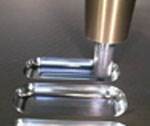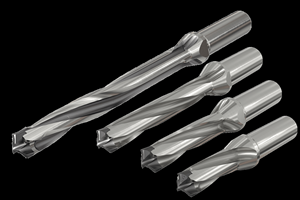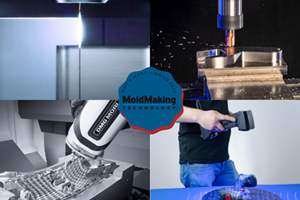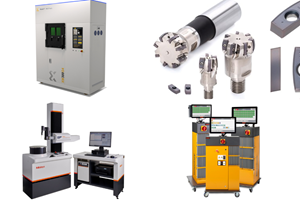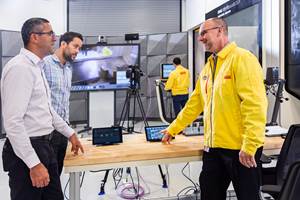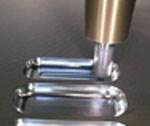How to Lower Leadtimes Through Spindle Retrofits
By adding a secondary high-speed spindle to their machining centers, moldmakers can gain higher speeds at a lower cost.
The finishing of molds has traditionally been a time consuming and costly process. The U.S. moldmaking industry has been under competitive pressures from offshore competitors who utilize lower labor costs to gain market share. The development of high-speed spindles and high-speed cutting tools has allowed moldmakers to avoid costly hand finishing operations, leading to reduced leadtimes, higher quality and lower overall manufacturing costs.
The effectiveness of the main spindle in a machining center to finish molds is limited by large, low-rpm, high-torque, high stock removal spindles. These spindles require large bearings for rigidity and therefore cannot perform high-speed machining (HSM) duties efficiently. Similarly, high-speed spindles cannot perform high stock removal operations due to a lack of bearing rigidity, but they are well suited for finishing of hardened molds.
Most moldmakers can't justify purchasing a dual machining center in addition to their current equipment. But it is now possible to gain the advantages of HSM by adding a secondary high-speed spindle to an existing machining center, which allows for the roughing and finishing cycle with one setup of the mold in one machine.
The basic machine requirements for maximizing the performance of an existing machining center are CNC memory capability to utilize axis speed and machine rigidity to maintain accuracy. The optimal CNC control should have sufficient memory to program long, complex toolpaths and the ability to compensate for changing acceleration and deceleration values.
The typical secondary spindle retrofit machine candidate has adequate rigidity to maintain accuracy during axis movements, yet lacks adequate spindle speed to utilize the axis in-feed capability of the machine. Machine tool rigidity and fast axis movements provide a standard basis for a cost effective high-speed spindle retrofit. However, older machines with adequate rigidity but insufficient axis speed capability may still provide a suitable foundation for some high-speed finishing applications.
What Is a Secondary Spindle System?
High-speed secondary spindle systems consist of an application-specific high-frequency spindle, a frequency converter, a spindle coolant unit and a wiring harness.
In addition, an oil/air coolant mist unit may be added in a system unit or cabinet to replace traditional flood cooling processes - minimizing coolant in the work environment and making disposal of coolant a non-issue. Spindle manufacturers who offer these new coolant mist systems usually integrate two-phase nozzles into their spindles, which allows for the oil mist to be specifically directed to the cutting zone.
Spindle tool holding interfaces are available for HSK and ISO toolholders (manual and automatic tool change) or direct clamping (manual). An ISO and HSK toolholder allows an accurate presetting of the cutting tool outside the machine.
Most secondary spindles can be mounted in the spindle taper of the existing main spindle or mounted directly onto the machine column. The main disadvantage of this is the loss in travel of the X-axis. The additional weight added to the column needs to be considered as well.
The installation of the secondary spindle in the main spindle taper allows for quick change from low- to high-speed operations and even allows the high-speed spindle to be used in multiple machines if the spindle drive and support system is portable in nature.
To mount the secondary spindle into the main spindle, tapers are available for ISO (Cat, BT) and HSK clamping systems. These mounting tapers can be changed on the secondary spindle if it is used on several machines with different taper systems.
New swivel mounting brackets to which the secondary spindle is mounted add B- and C-axis capability to the machine and can be clamped to the main spindle taper and main spindle housing for rigidity and no loss of axis travel.
Adding a secondary spindle also requires an additional frequency converter and a spindle coolant unit. Flexibility is important to the functionality of the entire spindle system. A compact, turnkey-ready system unit and an all function micro-processor control allow all spindle system functions to be easily interfaced to the machine CNC via analog or digital signals. A remote control unit monitoring and controlling all system function adds to the ease of operation of the secondary spindle system and adds to spindle use on multiple machines.
Summary
In moldmaking applications where both the roughing and the finishing process are required, one solution would be to purchase machines with either of these specific process capabilities. Another solution is to add a high-frequency, high-speed, secondary spindle system to an existing machining center, allowing it to perform both roughing and finishing operations.
The use of secondary high-speed spindle systems - costing from $20,000 to $40,000 depending on system configuration - offers moldmakers a chance to utilize existing CNC machines to their full potential and to maximize their capabilities in the most efficient way.
Related Content
Modular Tooling Systems Enable Versatility in Hole-Drilling Operations
The versatility of replaceable cutting edges offers users the ability to adapt to varied operations.
Read MoreMoldMaking Technology's Most-Viewed Content 2022: Products
MMT shares the five top-viewed technologies, equipment and services of 2022 in each Engineer, Build, Maintain and Manage tenet based on Google Analytics.
Read MoreProducts and Services for Multiple Moldmaking Needs
New year, new technology roundup! Featured here is a collection of product offerings, from profile milling cutters to industry-specific CAD/CAM software to innovative hot work tool steels.
Read MoreHow to Use Continuing Education to Remain Competitive in Moldmaking
Continued training helps moldmakers make tooling decisions and properly use the latest cutting tool to efficiently machine high-quality molds.
Read MoreRead Next
High-Speed Machining Simplified
How high-speed machining can be reliably achieved by using the principles applied along with the correct tooling, feeds and speeds.
Read MoreAre You a Moldmaker Considering 3D Printing? Consider the 3D Printing Workshop at NPE2024
Presentations will cover 3D printing for mold tooling, material innovation, product development, bridge production and full-scale, high-volume additive manufacturing.
Read MoreHow to Use Continuing Education to Remain Competitive in Moldmaking
Continued training helps moldmakers make tooling decisions and properly use the latest cutting tool to efficiently machine high-quality molds.
Read More
